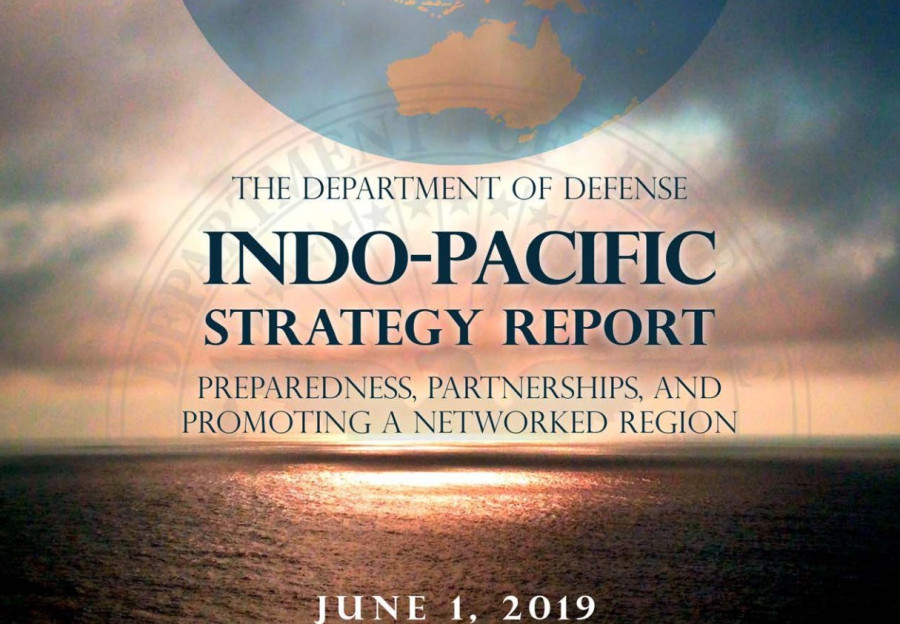National
Contrary to government claims, latest Indo-Pacific Strategy report includes Nepal in its State Partnership Program
Government officials denied any knowledge of the programme and pointed to the Army, which also denied knowledge about the partnership
Anil Giri
Even though the Nepal government categorically rejected any role and engagement in US-led Indo-Pacific Strategy, a recent report from the US Department of Defense states that the United States seeks to “expand” its defence relationship with Nepal under the ‘State Partnership Program in the Indo-Pacific.’
According to the ‘Indo-Pacific Strategy Report: Preparedness, Partnership, and Promoting a Networked Region’, released on Saturday, Nepal, along with Sri Lanka, has been “recently added”—in 2019—to the US’ ‘State Partnership Program in the Indo-Pacific’.
In South Asia, the US is working to operationalise major defence partnerships with India, while pursuing emerging partnerships with Sri Lanka, the Maldives, Bangladesh, and Nepal under the Indo-Pacific Strategy where the US seeks to expand its defence relationship with Nepal, focusing on “humanitarian assistance and disaster response, peacekeeping operations, defence professionalisation, ground force capacity, and counter-terrorism,” the report says.
With Nepal’s inclusion in the Indo-Pacific Strategy report, many observers wonder what understanding the country had with the United States and what assistance it and the Nepal Army would receive under the new State Partnership Program.
Top government officials told the Post that the US had shared the report with officials in the KP Sharma Oli administration before it was released to the media.
“Big powers are free to chart out their strategy and they may include us, but it does not mean that we have to accept them,” said a senior Nepal government official familiar with the report. “Nepal has not made any commitments to them. We haven’t said yes or no, so we have not made any commitment to the Indo-Pacific Strategy.” The official refused to identify himself and his ministry as he was not allowed to speak with the media.
Government officials said that larger engagements could have been agreed to by the Nepal Army as it is solely responsible for agreements, pacts or understandings reached with the US.
When the Post reached out to the Nepal Army, Brigadier Bigyan Dev Pandey, the force’s spokesperson, said that he was not aware of any such communication at the Nepal Army headquarters.
Baburam Gautam, spokesperson at the Ministry of Defence, too said that he had no idea about any formal communication regarding Nepal’s inclusion in the State Partnership Program under the Indo-Pacific Strategy.
The State Partnership Program, which originated in 1993, is a joint Department of Defense programme managed by the National Guard of designated US states and countries that are part of the Indo-Pacific Strategy. Eighty-six nations are already part of the programme.
The programme primarily focuses on disaster response, aviation safety and operations, leadership development, military medical fields, and cyber defence, among others. Its objectives include meeting US national security goals while maintaining relationships with “some of our [US’] staunchest allies and partners in every corner of the world.”
Suresh Chalise, former Nepali Ambassador to the United States, told the Post that since the primary purpose of the Indo-Pacific Strategy is to counter China, Nepal needs to adopt “strategic autonomy” to maintain a balance between the two major powers.
“We should not be part of any global initiatives of major powers without analysing the merits and demerits,” said Chalise. “We should adopt a pragmatic foreign policy by not becoming part of a rivalry or competition between major powers. We should only partner for the sake of our own interest, while maintaining strategic autonomy.”
In December, Foreign Minister Pradeep Gyawali visited the United States and met with US Secretary of State Mike Pompeo. During the meeting, according to a State Department statement, Nepal’s “central role” in a free, open and prosperous Indo-Pacific was discussed.
After returning to Nepal, Gyawali, at a press conference on December 24 at the Ministry of Foreign Affairs, rejected outright reports about Nepal’s inclusion and support for the Indo-Pacific Strategy.
“Since Nepal is the chair nation of SAARC and a member state of BIMSTEC, the US reckons that Nepal can play a crucial role in the Indo-Pacific region. But the reports about the US including Nepal in its Indo-Pacific strategy are false,” Gyawali had told reporters, emphasising that ‘region’ and ‘strategy’ are two different things.
But the US has consistently been urging Nepal to play a key role in a free and open Indo-Pacific through several US officials in Nepal.
During his visit to Kathmandu in May, Acting Deputy Assistant Secretary of State for South Asia David J Ranz told reporters that the Millennium Challenge Corporation, where the US has outlined a $500 million grant to Nepal for infrastructure projects, is very much part of the strategy.
Ranz said that the US is asking Nepal to be “for” the principles that have already helped
Nepal and the Indo-Pacific region prosper—principles like freedom, good governance, and transparency—and to be vigilant and outspoken against anyone who violates those principles and norms.
The report also outlines a series of the US’ engagements with Nepal, which it calls in an “upward trajectory”. “Our growing defense partnership can be seen in the establishment of the US Army Pacific-led Land Forces Talks in June 2018, our senior-most military dialogue with Nepal. This year has already seen several senior-level visits to Nepal by the USINDO/PACOM Commander and Deputy Assistant Secretary of Defense for South and Southeast Asia to further advance our defense relationship,” states the report.
“To uphold a free and open Indo-Pacific, we will base our outreach and activities in the region on our strong alliances and partnerships,” the report says.




 16.12°C Kathmandu
16.12°C Kathmandu















